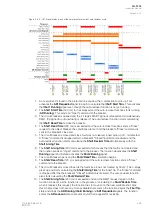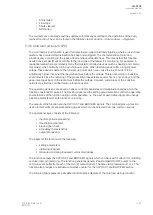
Auto-recloser in meshed or ring networks
A typical auto-recloser scheme cannot be applied directly to an overhead line network that has a
distributed generation (DG) component; this situation will become more common as renewable power
sources become more widespread. Instead, this requires a two-end auto-recloser scheme where the
two relays at both ends of the line function in a master–follower operation. The DG power plant must be
disconnected from the rest of the network before the breaker's "Close" command is applied; otherwise
the plant keeps the fault on during the auto-recloser's dead time and thus fails the reclosing.
Additionally, when the main grid is disconnected from the DG power plant, the closing of the breaker is
likely to cause phase shifting issues during the dead time.
Figure. 5.4.4 - 192. Auto-reclosing with distributed generation in the line.
This operation requires a link between the 110/20 kV substation's master relay and the 20 kV collector
substation's follower relay. When the auto-recloser function is initiated, the collector station's breaker is
opened and remains open until the auto-recloser sequence is over as there is no reason to close the
breaker until the auto-recloser cycle has successfully cleared the fault. When the sequence is
succesful, the collector substation's breaker is given permission to close after the reclaim time; the
breaker should be closed with the Synchrocheck function.
Once the collector substation is disconnected, the previously described basic principles of auto-
reclosing apply. This method applies to all meshed or ring networks where the same line is fed power
from multiple directions. This problem does not exist for typical consumer (radial) networks.
Arcing time and discrimination time
Generally, after the dead time has elapsed and the breaker is closed by the auto-recloser, this
happens: the reclaim time starts calculating and if the process is interrupted by a new reclosing
request, the function continues to the next state (the next available shot, or the Final Trip if no more
shots are available). However, the user can use the "Shot action time" setting to contol this behavior.
The two settings are mutually exclusive: when "Arcing" is selected for a shot, "Discrimination" cannot be
selected for the same shot.
The "Arcing" setting is used to control the auto-recloser when the START signal of a stage makes the
requests. If the request (e.g. I> START) activates during the reclaim time, an arcing time calculation
begins. If the fault persists, the function continues to the next state. If an arcing time calculation begins
but stops before the set time has passed, the reclaim calculation continues normally. When that time
has elapsed, the auto-recloser function returns either to the general reclaim time or to the Ready
mode; the shot is considered successful. The arcing time counter does not reset when the reclaim
calculation continues: every time it activates, it continues from where it left off. This means that the time
set to the "ARx Shot action time" parameter is a cumulative counter of time allowed before deciding
whether a shot is failed or successful.
A
AQ
Q-F205
-F205
Instruction manual
Version: 2.04
© Arcteq Relays Ltd
IM00013
273
Summary of Contents for AQ F205
Page 1: ...AQ F205 Feeder protection IED Instruction manual ...
Page 2: ......













































